Collection of guano in Peru (23 photos)
 Bashny.Net
Bashny.Net
You know what guano? I think so. See - how and why it is mined.
1. Thousands of birds on the island Ballestas, south of Lima, October 10, 2011. Ballestas and 21 island off the coast of Peru, is home to nearly four million migratory birds such as cormorants Bougainville, boobies and pelicans. Of bird excrement made the best natural fertilizer in the world. Bird droppings, also known as guano, reached the greatest economic importance in the nineteenth century, when it began to be exported to the United States, England and France. Today, when the annual production of more than 20 thousand tons, Peru counts mainly on orders from small farmers. (REUTERS / Pilar Olivares)

2. footed boobies nesting on the island Ballestas south of Lima, on October 9, 2011. Birds nest on the island, leaving behind - not counting the corpses of their relatives - tons of manure. Drought makes him a caustic mixture of nitrogen and phosphorus compounds, potassium oxide and quicklime. Its name - one of the few words that the world has borrowed from the language of the Incas: "guano". (REUTERS / Pilar Olivares)

3. Working scraped bird droppings off the rocks, Ballestas island, south of Lima, October 8, 2011. (REUTERS / Pilar Olivares)
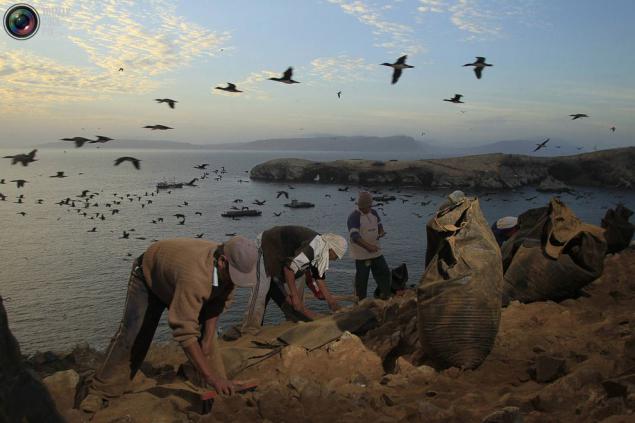
4. Working with bird droppings scraped stones, Ballestas island, south of Lima, early morning October 10, 2011. (REUTERS / Pilar Olivares)

5. Usually, mining guano intermittently. Most of the islands do not touch for ten years. All this time there lived a lone watchman who guards the birds. During this time, the islands are covered by a layer of litter thickness of half a meter. And then come to work. (REUTERS / Pilar Olivares)
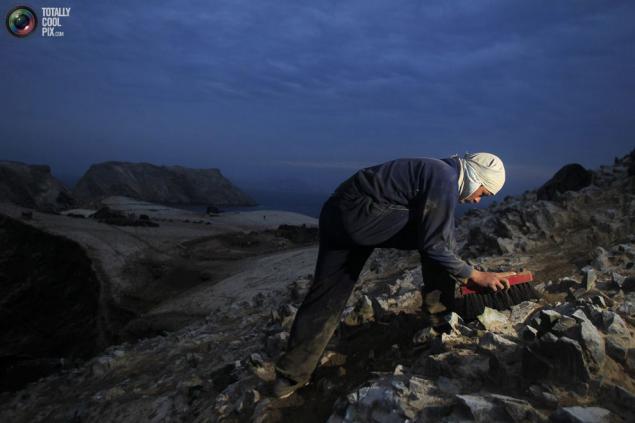
6. All work on the island is done manually. Even when loading when you need to transport tons of guano packed, people use classical mechanics: put the platform, put it on the cross, double rope, cargo transfer is carried out using a hook and gravity. (REUTERS / Pilar Olivares)
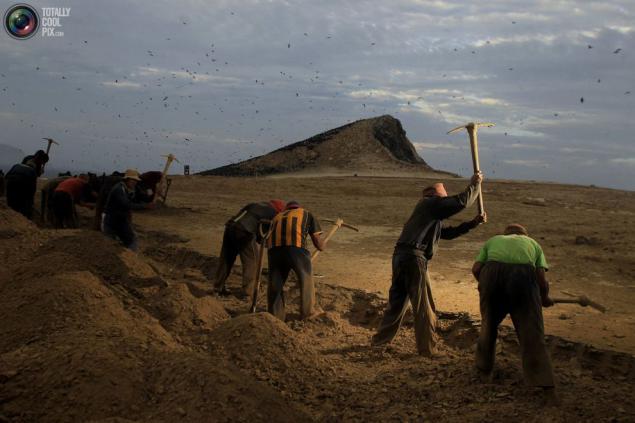
7. Workers collect guano island Ballestas, south of Lima, October 8, 2011. Significant deposits of guano found in South America (Peru, Bolivia), South Africa (for example, an island off the coast of Namibia Ichabo), the Pacific Islands. (REUTERS / Pilar Olivares)
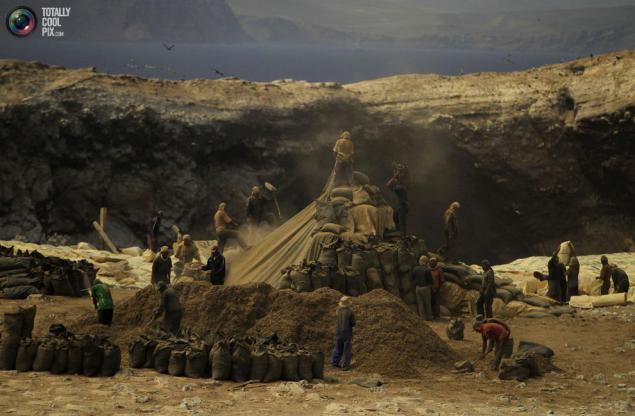
8. Work passes a bag of guano other workers to processing, Ballestas island, south of Lima, October 8, 2011. (REUTERS / Pilar Olivares)

9. Work throws a bag from under the guano island Ballestas, south of Lima, October 8, 2011. (REUTERS / Pilar Olivares)

10. No one knows exactly when mankind began to mine the guano. The first entry in the archives of the company, which is engaged in the pometodobychey Guanyape Norte, made in 1851. But on some islands of the archipelago crap archaeologists found tools dating back to the era of the ancestors of the Incas. (REUTERS / Pilar Olivares)
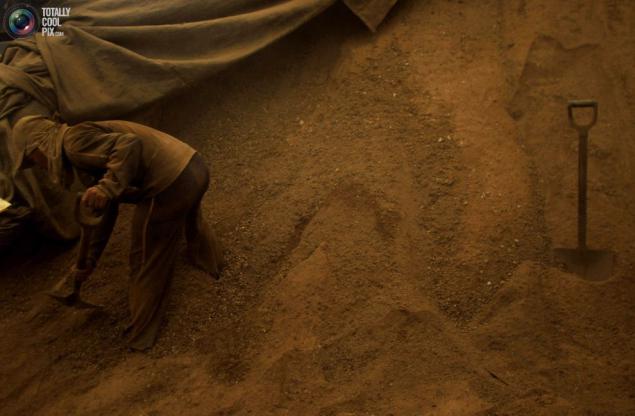
11. In the XIX century the guano was a strategic raw materials Peru, the demand for fertilizer has grown around the world. (REUTERS / Pilar Olivares)

12. Bird droppings in the 19th century is so important that the United States in 1856 passed a law under which US citizens can take in his possession any unattended island if there gadili birds. (REUTERS / Pilar Olivares)
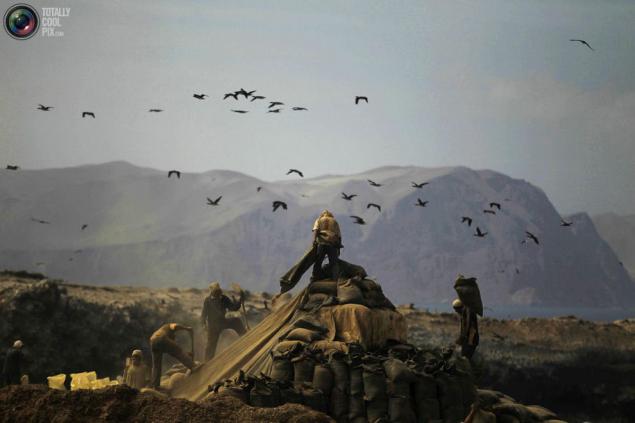
13. Processing of bird droppings on the island Ballestas, south of Lima, October 8, 2011. (REUTERS / Pilar Olivares)
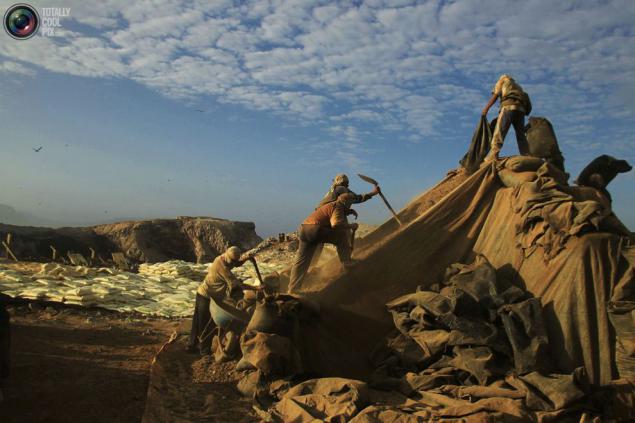
14. Work with a trolley to collect guano island Ballestas, south of Lima, October 11, 2011. (REUTERS / Pilar Olivares)

15. Processing of bird droppings on the island Ballestas, south of Lima, October 8, 2011. (REUTERS / Pilar Olivares)

16. Workers collect bird droppings, Ballestas island, south of Lima, October 8, 2011. (REUTERS / Pilar Olivares)

17. Work (center) on the background of cormorants flying by Bougainville Island Ballestas, south of Lima, on October 9, 2011. (REUTERS / Pilar Olivares)

18. Workers carry sacks of bird droppings, Ballestas island, south of Lima, on October 9, 2011. (REUTERS / Pilar Olivares)
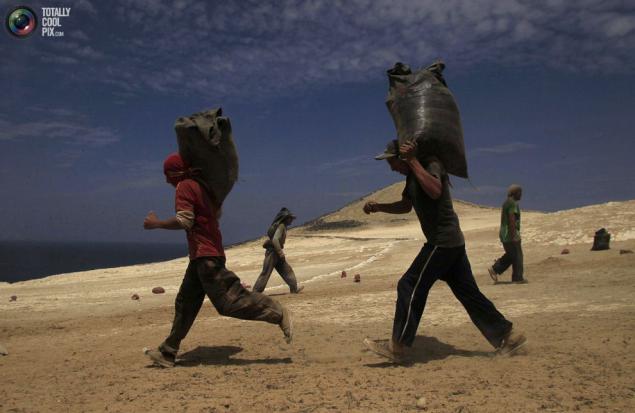
19. Workers collect bird droppings on the field, Ballestas island, south of Lima, October 8, 2011. (REUTERS / Pilar Olivares)
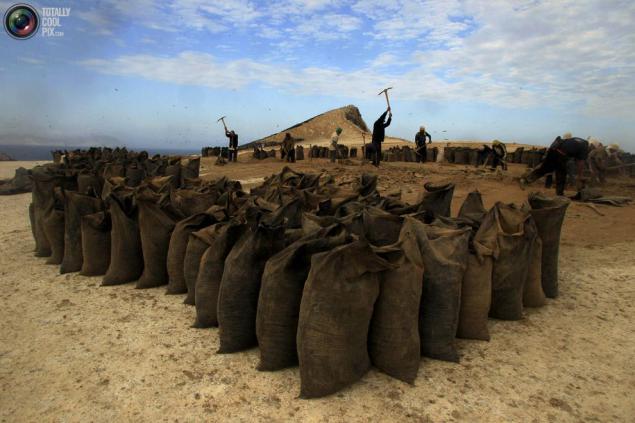
20. A worker walks between bags of bird droppings, Ballestas island, south of Lima, October 10, 2011. (REUTERS / Pilar Olivares)
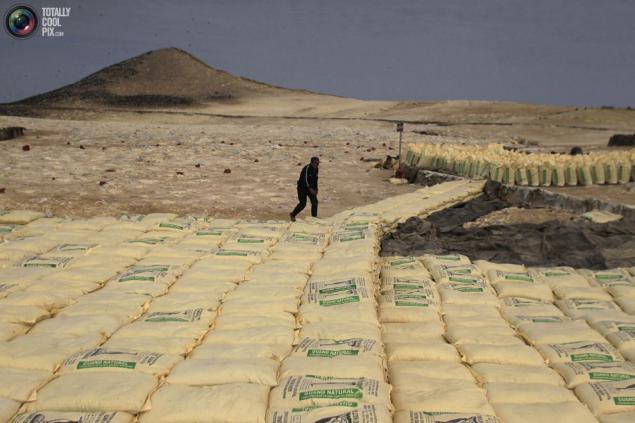
21. Work during the break, Ballestas island, south of Lima, October 10, 2011. (REUTERS / Pilar Olivares)
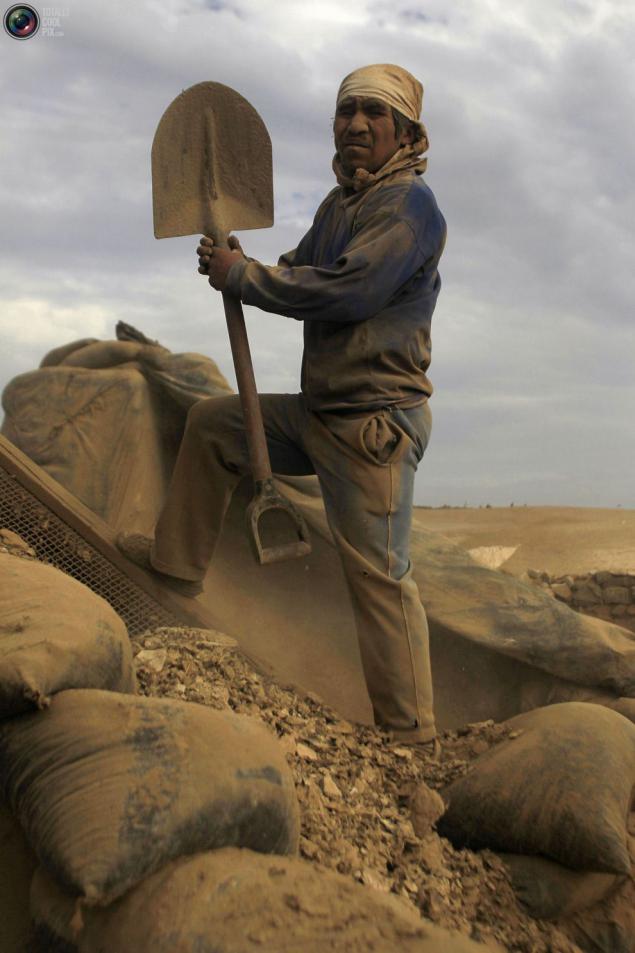
22. Work during the break, Ballestas island, south of Lima, October 11, 2011. (REUTERS / Pilar Olivares)
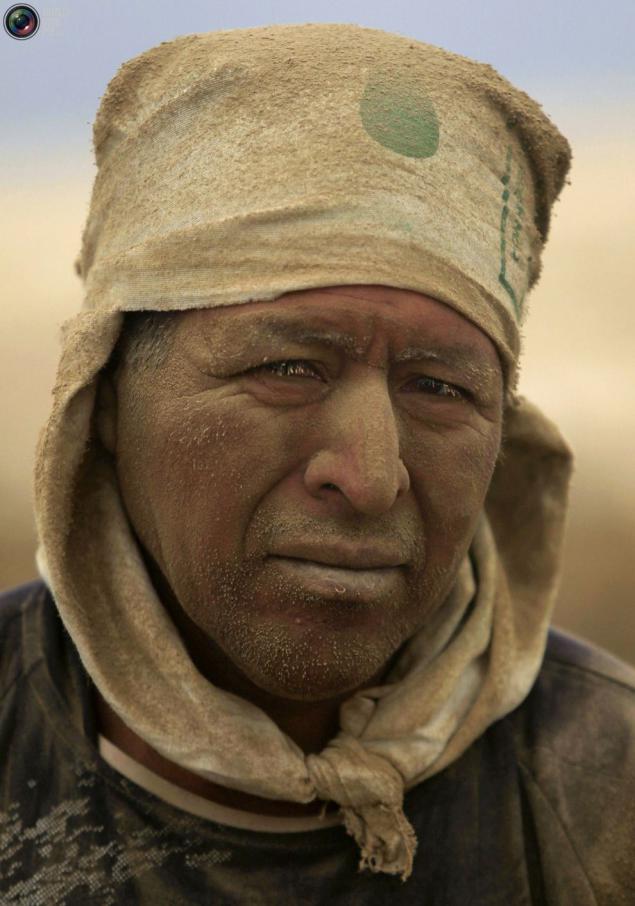
23. Work dumps guano from carts for recycling, Ballestas island, south of Lima, on October 9, 2011. (REUTERS / Pilar Olivares)

1. Thousands of birds on the island Ballestas, south of Lima, October 10, 2011. Ballestas and 21 island off the coast of Peru, is home to nearly four million migratory birds such as cormorants Bougainville, boobies and pelicans. Of bird excrement made the best natural fertilizer in the world. Bird droppings, also known as guano, reached the greatest economic importance in the nineteenth century, when it began to be exported to the United States, England and France. Today, when the annual production of more than 20 thousand tons, Peru counts mainly on orders from small farmers. (REUTERS / Pilar Olivares)

2. footed boobies nesting on the island Ballestas south of Lima, on October 9, 2011. Birds nest on the island, leaving behind - not counting the corpses of their relatives - tons of manure. Drought makes him a caustic mixture of nitrogen and phosphorus compounds, potassium oxide and quicklime. Its name - one of the few words that the world has borrowed from the language of the Incas: "guano". (REUTERS / Pilar Olivares)

3. Working scraped bird droppings off the rocks, Ballestas island, south of Lima, October 8, 2011. (REUTERS / Pilar Olivares)

4. Working with bird droppings scraped stones, Ballestas island, south of Lima, early morning October 10, 2011. (REUTERS / Pilar Olivares)

5. Usually, mining guano intermittently. Most of the islands do not touch for ten years. All this time there lived a lone watchman who guards the birds. During this time, the islands are covered by a layer of litter thickness of half a meter. And then come to work. (REUTERS / Pilar Olivares)

6. All work on the island is done manually. Even when loading when you need to transport tons of guano packed, people use classical mechanics: put the platform, put it on the cross, double rope, cargo transfer is carried out using a hook and gravity. (REUTERS / Pilar Olivares)

7. Workers collect guano island Ballestas, south of Lima, October 8, 2011. Significant deposits of guano found in South America (Peru, Bolivia), South Africa (for example, an island off the coast of Namibia Ichabo), the Pacific Islands. (REUTERS / Pilar Olivares)

8. Work passes a bag of guano other workers to processing, Ballestas island, south of Lima, October 8, 2011. (REUTERS / Pilar Olivares)

9. Work throws a bag from under the guano island Ballestas, south of Lima, October 8, 2011. (REUTERS / Pilar Olivares)

10. No one knows exactly when mankind began to mine the guano. The first entry in the archives of the company, which is engaged in the pometodobychey Guanyape Norte, made in 1851. But on some islands of the archipelago crap archaeologists found tools dating back to the era of the ancestors of the Incas. (REUTERS / Pilar Olivares)

11. In the XIX century the guano was a strategic raw materials Peru, the demand for fertilizer has grown around the world. (REUTERS / Pilar Olivares)

12. Bird droppings in the 19th century is so important that the United States in 1856 passed a law under which US citizens can take in his possession any unattended island if there gadili birds. (REUTERS / Pilar Olivares)

13. Processing of bird droppings on the island Ballestas, south of Lima, October 8, 2011. (REUTERS / Pilar Olivares)

14. Work with a trolley to collect guano island Ballestas, south of Lima, October 11, 2011. (REUTERS / Pilar Olivares)

15. Processing of bird droppings on the island Ballestas, south of Lima, October 8, 2011. (REUTERS / Pilar Olivares)

16. Workers collect bird droppings, Ballestas island, south of Lima, October 8, 2011. (REUTERS / Pilar Olivares)

17. Work (center) on the background of cormorants flying by Bougainville Island Ballestas, south of Lima, on October 9, 2011. (REUTERS / Pilar Olivares)

18. Workers carry sacks of bird droppings, Ballestas island, south of Lima, on October 9, 2011. (REUTERS / Pilar Olivares)

19. Workers collect bird droppings on the field, Ballestas island, south of Lima, October 8, 2011. (REUTERS / Pilar Olivares)

20. A worker walks between bags of bird droppings, Ballestas island, south of Lima, October 10, 2011. (REUTERS / Pilar Olivares)

21. Work during the break, Ballestas island, south of Lima, October 10, 2011. (REUTERS / Pilar Olivares)

22. Work during the break, Ballestas island, south of Lima, October 11, 2011. (REUTERS / Pilar Olivares)

23. Work dumps guano from carts for recycling, Ballestas island, south of Lima, on October 9, 2011. (REUTERS / Pilar Olivares)

Tags
See also
Photos that are impossible to look indifferently (36 photos)
Photos that are impossible to look indifferently (36 photos)
Best photos for November 2012
National Geographic Photos
Madonna's new tour
When his father photographer or 25 crazy photo of two girls
Mexico. 5000 km
Photos that are impossible to look indifferently
Photographer Aaron Nace - creative, unusual, different (58 photos)
Is there any truth in the legs

















